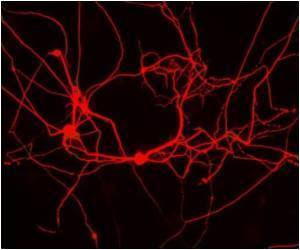New research by scientists shows at the single cell level how an external stimulus sets off a molecular chain reaction in the transparent roundworm C. elegans.

"We've known the broad outline of how a behavior circuit works-a stimulus starts a neuronal cascade, which ultimately activates a muscle cell-for decades," said Mark Alkema, PhD, assistant professor of neurobiology. "The details about how this process works, however, such as which neurotransmitters act through which receptors in which neurons have remained a mystery for even the simplest of behaviors.
"This research provides an answer to the simple question of how the worm turns around and the broader question of how a behavioral sequence is produced on a sub-cellular level. In time, understanding voluntary movement in humans will require answering the same questions about the timing and location of neurons and neurotransmitters-only in the infinitely more complex variety of circuits in the human nervous system," said Dr. Alkema.
Roundworms move by alternately relaxing and contracting ventral and dorsal muscles along both sides of its body. As the animal moves forward, it uses its head to probe for possible threats. A gentle touch to the head of the worm initiates an escape response resulting in the animal ceasing head movements and quickly moving backwards. This initial reaction is closely followed by a deep ventral turn allowing it to move away in the opposite direction.
Earlier studies have shown that tyramine, a monoamine neurotransmitter akin to noradrenaline in humans, is involved in the C. elegans escape response. Specifically, C. elegans have a pair of tyraminergic motor neurons that are essential for coordinating the initial suppression of head movement and the backing response. These neurons release tyramine, which works through a fast-acting ion channel called LGC-55 to inhibit forward movement and relax the neck muscles. How the animal coordinates this movement with the subsequent deep turn that allows it to complete the change in direction and move away from the threat, however, was unknown. In this study, the authors provide evidence that links this initial phase of the escape response to the later stages in which the worm makes a sharp turn and navigates away from the danger.
When C. elegans are placed on a surface containing a high concentration of tyramine they become immobilized. Alkema and colleagues found that this paralysis could be overcome by mutating the C. elegans gene responsible for encoding the G-protein coupled receptor SER-2. Additionally, they found that the SER-2 receptor was active in a set of 13 neurons residing along the ventral nerve cord. The synapses of these neurons were connected to corresponding ventral muscles cells along one side of the worm's body.
Advertisement
"This study shows how tyramine works through separate receptors to produce a complex behavior requiring the temporal coordination of independent motor programs," said Alkema. "Acting through the fast-acting ionotropic receptor LGC-55, the animal completes the initial movement by ceasing head movement and backing away. At the same time, the slow-acting SER-2 receptor is also being activated by tyramine to complete the turn and facilitate movement in the opposite direction.
Advertisement
Source-Eurekalert









